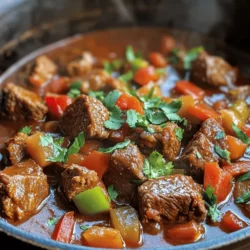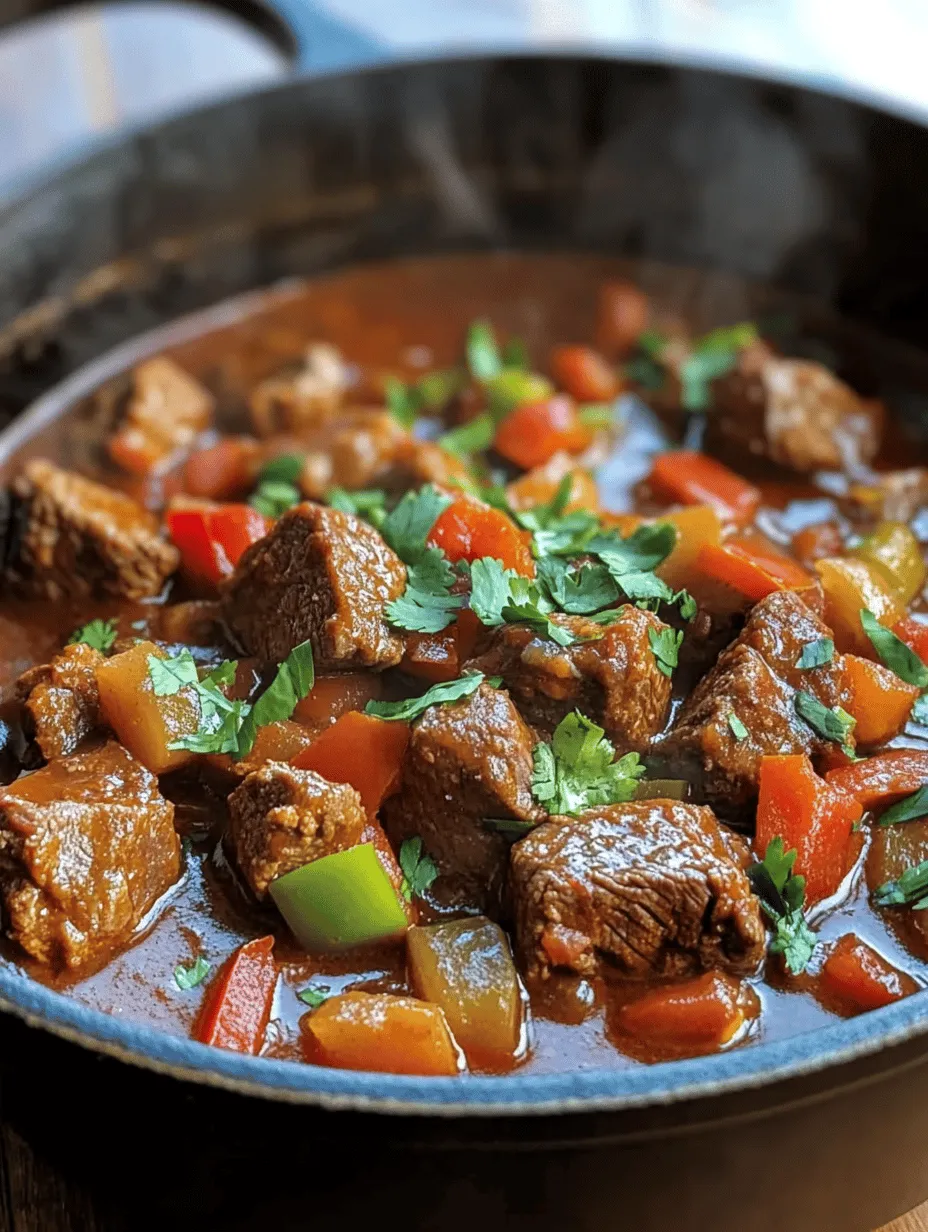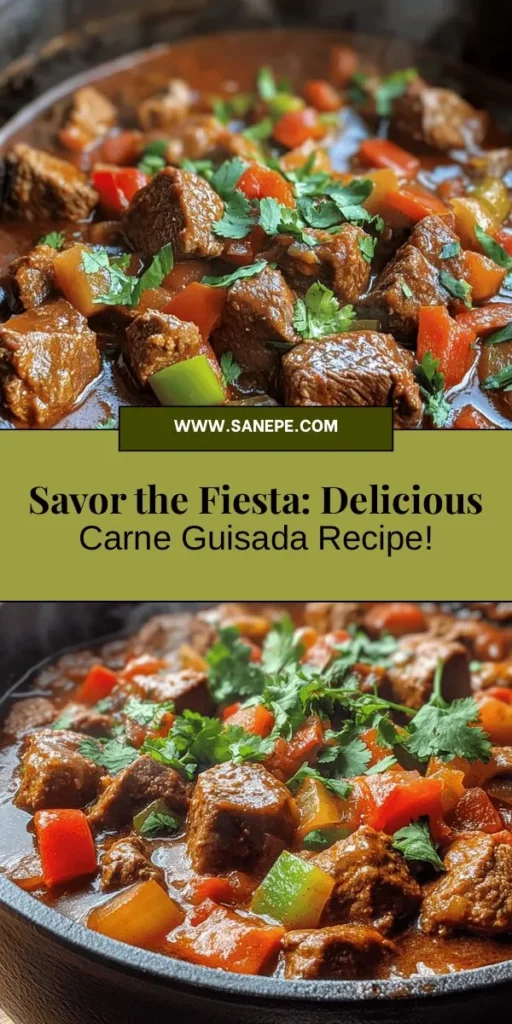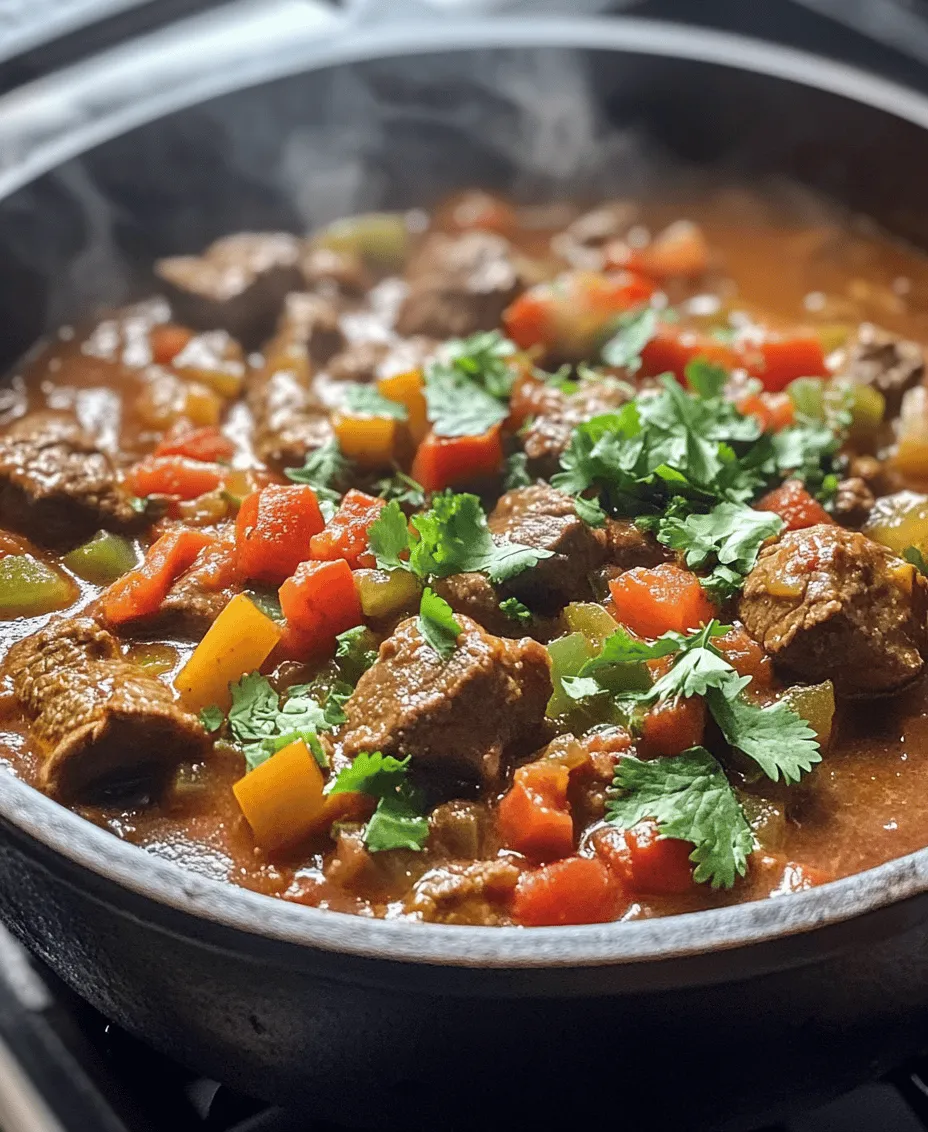Introduction
Carne guisada, a traditional Latin American dish, is a hearty and flavorful stew that embodies comfort food at its finest. Rooted in rich culinary traditions, this savory dish brings together tender chunks of beef, an array of vibrant vegetables, and a harmonious blend of spices that create a symphony of flavors. Whether served over rice, with tortillas, or alongside beans, carne guisada promises to be a feast for both the eyes and the palate.
In this article, we will delve into the history and cultural significance of carne guisada, provide step-by-step instructions for preparing the dish, explore variations to suit different tastes, and offer tips for serving. Prepare to indulge in a fiesta of flavors with this delightful dish!
Understanding Carne Guisada
Exploring the Origins of Carne Guisada
Historically, carne guisada has roots that stretch across several Latin American countries, including Mexico, Puerto Rico, and Cuba. Each region has its own unique take on the dish, influenced by local ingredients, cooking techniques, and cultural traditions. The term “guisada” itself comes from the Spanish word “guisar,” which means to stew, indicating the slow-cooking process that is essential for developing the rich flavors associated with this dish.
In Mexico, carne guisada often features a tomato-based sauce with a medley of spices, creating a robust and hearty stew. In Puerto Rico, it might incorporate the use of sofrito, a blend of herbs and spices that adds depth and flavor. Meanwhile, in Cuba, the dish may have a slightly sweeter profile, sometimes including ingredients like olives or raisins. This fusion of flavors exemplifies the adaptability of carne guisada, making it a beloved staple in many households.
The Significance of Carne Guisada in Latin American Cuisine
Carne guisada holds a special place in Latin American cuisine, often being the centerpiece of family gatherings and celebrations. It is a dish that speaks to the heart of home cooking, where the preparation and sharing of food brings loved ones together. In many cultures, the act of cooking carne guisada is steeped in tradition, with recipes passed down through generations. The dish is often served during special occasions, such as holidays or family reunions, symbolizing warmth, love, and community.
In addition to its role in gatherings, carne guisada is celebrated for its versatility. It can be customized to fit different tastes, dietary preferences, and regional ingredients, making it accessible to a variety of palates. This adaptability contributes to its enduring popularity, as families create their own versions while still honoring the essence of this beloved stew.
Ingredients Overview
Essential Ingredients for an Authentic Carne Guisada
To create a truly authentic carne guisada, it’s vital to select the right ingredients. The type of beef used can significantly impact the final flavor and texture of the dish. While various cuts can work, beef chuck is often recommended due to its balance of tenderness and flavor. This cut becomes incredibly succulent and rich when simmered slowly in the stew. Brisket is another excellent option, providing a deep beefy flavor that enhances the overall dish.
In addition to the beef, the freshness of vegetables and herbs plays a crucial role in the outcome of carne guisada. Commonly used vegetables include onions, bell peppers, and garlic, all of which contribute aromatic qualities essential for layering flavors. Fresh herbs, such as cilantro or parsley, can also be added at the end for a burst of freshness.
Spices That Make a Difference
The true magic of carne guisada lies in its spices. A well-balanced blend not only enhances the flavor but also adds depth and complexity to the dish. Key spices include chili powder, cumin, paprika, and oregano. Chili powder provides a gentle heat, while cumin brings an earthy, warm note. Paprika adds a subtly sweet smokiness, and oregano lends an aromatic touch.
Another often-overlooked ingredient is the bay leaf. Used during the cooking process, bay leaves impart a unique flavor that harmonizes with the other spices. It’s important to remember to remove the bay leaves before serving, as they are inedible.
Step-by-Step Cooking Instructions
Preparing the Ingredients
Before diving into the cooking process, it is essential to prepare your ingredients meticulously. Start by cutting the beef into bite-sized chunks, approximately 1-2 inches. This size allows for even cooking and ensures that each piece becomes tender and flavorful. For the vegetables, finely chop the onions and bell peppers, and mince the garlic to maximize their flavors when sautéed.
Using the right kitchen tools can also enhance your cooking experience. A sharp chef’s knife will make cutting the beef and vegetables easier, while a sturdy cutting board provides a stable surface. Additionally, having a heavy-bottomed pot or Dutch oven on hand is crucial for even heat distribution during cooking.
Searing the Meat to Perfection
One of the most critical steps in achieving a flavorful carne guisada is the searing of the meat. Begin by heating a few tablespoons of oil in your pot over medium-high heat. Once the oil is hot, add the beef chunks in batches to avoid overcrowding the pot. Searing the meat creates a beautiful brown crust, which is essential for developing rich flavors in the stew.
Aim for a cooking temperature of around 350°F to achieve that perfect sear. Allow the beef to cook undisturbed for a few minutes before flipping to promote even browning. Once browned on all sides, remove the beef from the pot and set it aside. This step will enhance the overall depth of flavor in your carne guisada.
Sautéing the Vegetables
With the beef set aside, it’s time to turn your attention to the vegetables. In the same pot, add a bit more oil if needed, and lower the heat to medium. Begin by sautéing the chopped onions, allowing them to soften and become translucent—this should take about 5-7 minutes. Next, add the minced garlic and bell peppers, stirring frequently to prevent burning. The aromatic combination of onions, garlic, and bell peppers will create a flavorful base for your carne guisada.
Cook the vegetables for an additional 3-4 minutes until they are tender and fragrant. This step is crucial, as it helps to build the foundation of flavors that will meld beautifully with the beef once reintroduced to the pot.
Stay tuned for the next part of this article, where we will continue with the cooking instructions and explore variations and serving suggestions for this delightful carne guisada recipe!
Maintaining the Right Balance of Flavors
Creating the perfect carne guisada relies heavily on maintaining a harmonious balance of flavors. This dish is known for its rich, savory profile and the depth that comes from slow cooking. Here are some essential tips for building that rich flavor base and ensuring your carne guisada is nothing short of spectacular.
Building the Rich Flavor Base
The foundation of any successful carne guisada begins with sautéing the aromatics. Start by heating a large pot or Dutch oven over medium heat, adding a splash of oil, and then introducing onions and garlic. These ingredients are crucial as they not only contribute sweetness but also enhance the overall depth of flavor. After the onions become translucent, add diced bell peppers for an additional layer of taste.
Once your aromatics are sautéed, it’s time to introduce the meat. For the most flavor, consider browning the beef on all sides. This step is key as it creates a Maillard reaction that adds a complex flavor profile to the dish. Afterward, deglaze the pot with beef broth or a splash of red wine, scraping up any browned bits on the bottom. This is where much of your flavor resides.
Combining Ingredients Effectively for Depth of Flavor
When adding spices and seasonings, think about their role in building complexity. Cumin, oregano, and bay leaves are traditional additions to carne guisada. However, feel free to experiment with smoked paprika or a hint of chili powder for an extra kick. Remember to add these spices at different stages: some can be added during the initial sautéing, while others might be better off added later in the cooking process to preserve their potency.
Incorporating tomatoes—either fresh, canned, or in the form of tomato paste—into the mix will provide acidity and sweetness, balancing the richness from the beef. You could also include diced carrots or potatoes for additional texture and flavor. As the stew simmers, the flavors will meld beautifully, creating a vibrant and satisfying dish.
Adjusting Seasoning for Personal Taste
Taste is subjective, and every palate is different. As your carne guisada simmers, make sure to taste and adjust the seasoning. This might involve adding a pinch of salt, a dash of black pepper, or even a squeeze of fresh lime juice to brighten the dish. The goal is to create a balance that works for you and your guests.
The Art of Slow Cooking
One of the hallmarks of carne guisada is its slow-cooked tenderness. This method allows the flavors to develop fully, resulting in melt-in-your-mouth meat that is infused with the aromatic essence of the other ingredients.
Benefits of Slow Cooking for Tenderness and Flavor Infusion
Slow cooking not only tenderizes the meat but also allows the spices and aromatics to permeate every bite. As the beef simmers, the connective tissues break down, making the meat more succulent. Unlike quick cooking methods, slow cooking encourages a rich amalgamation of flavors, resulting in a stew that is hearty and satisfying.
Recommended Cooking Times and Temperature Settings
For optimal results, cook your carne guisada on low heat for about 2 to 3 hours. If you’re using a slow cooker, set it on low for 6 to 8 hours. The low-and-slow method is paramount for achieving that perfect texture and flavor. If you’re in a hurry, you can opt for a pressure cooker, which can significantly reduce cooking time while still delivering tender results.
Checking for Doneness
Knowing when your carne guisada is ready to serve is crucial for achieving the best flavor and texture.
Signs That the Carne Guisada Is Ready to Serve
The best indicator of doneness is the tenderness of the meat. If it shreds easily with a fork, you know your dish is ready. Additionally, the sauce should be thickened and flavorful, coating the back of a spoon.
Tips for Adjusting Flavors Before Serving
Before serving, taste the carne guisada one last time. If it needs a little more depth, consider adding a splash of vinegar or a dash of hot sauce to enhance the flavors. Fresh herbs like cilantro can be added just before serving to provide a burst of freshness that complements the rich stew.
Serving Suggestions
Once your carne guisada is ready, it’s time to think about how to serve it. This dish is versatile and can be enjoyed in various ways.
Best Accompaniments for Carne Guisada
Traditional side dishes that pair beautifully with carne guisada include:
– Flour Tortillas: Soft and warm, tortillas are perfect for scooping up the stew and creating mini tacos.
– White Rice: A side of fluffy white rice helps absorb the flavorful sauce, making each bite satisfying.
Suggested Toppings and Garnishes
Enhance your carne guisada with toppings like fresh cilantro, diced onions, or a squeeze of lime for a zesty finish. You could also add avocado slices or crumbled queso fresco for additional creaminess.
Creative Serving Ideas
Carne guisada isn’t just a stew; it can be the star of many dishes:
– Tacos or Burritos: Use the carne guisada as a filling for soft or hard-shell tacos. Add your favorite toppings for a personalized touch.
– Enchiladas: Roll carne guisada in corn tortillas, cover with a rich enchilada sauce, and bake for a delightful twist.
Variations of Carne Guisada
While traditional carne guisada holds a special place in many homes, there are plenty of variations to explore.
Vegetarian or Vegan Alternatives
For those looking to enjoy carne guisada without meat, consider using plant-based proteins like jackfruit, tofu, or tempeh. These alternatives can absorb flavors well and provide a satisfying texture. Adjust the spices to enhance the flavor without meat; for instance, smoked paprika and liquid smoke can add a depth reminiscent of slow-cooked beef.
Regional Variations to Explore
Carne guisada varies across cultures, each bringing unique ingredients and preparation methods.
– Mexican Variations: Often include additional spices such as chipotle or adobo sauce for a smoky flavor.
– Puerto Rican Style: Typically features a sweeter profile with the addition of ingredients like olives or capers.
– Cuban Adaptations: May incorporate a sofrito (a blend of sautéed garlic, onions, peppers, and spices) for a distinctive flavor.
Conclusion
Carne guisada is more than just a meal; it’s a celebration of flavors that brings people together. This dish’s rich history and cultural significance make it a beloved favorite across many households. By following this detailed recipe, you can create a warm, inviting dish that will delight your family and friends. Whether you’re enjoying it with traditional sides or experimenting with variations, carne guisada is sure to become a staple in your culinary repertoire. Embrace the fiesta of flavors and savor every bite!



